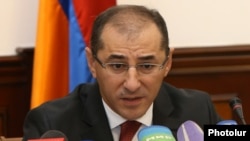Armenia’s economy will grow by around 5 percent annually in the coming years thanks to reforms planned by the government, Finance Minister Vartan Aramian insisted on Thursday.
Aramian stood by ambitious growth targets that were set by the government in its five-year policy program approved by the parliament on June 22. The 120-page program says that faster growth will cut the official poverty rate, which currently stands at around 30 percent, by 12 percentage points by 2022.
The International Monetary Fund, the World Bank and even the Central Bank of Armenia (CBA) have forecast lower growth rates for the next few years.
Prime Minister Karen Karapetian asked Aramian about the reasons for the CBA’s less optimistic outlook at a weekly cabinet meeting in Yerevan.
“The Central Bank esimates growth potential for the next three years at 3.2 percent to 4.5 percent,” the minister replied. “With the mid-term spending program [for 2018-2020] presented by us, we expect growth rates of 4.7 percent, 5 percent, and up to 5.7 percent in the coming years.”
He said that the CBA expects more modest rises in investments and domestic consumption than the Finance Ministry.
The Armenian authorities posted virtually zero GDP growth last year amid a continuing recession in Russia. They say that it will accelerate to at least 3.2 percent this year.
The government program describes exports as “the key engine” of the projected faster growth. It says that the government will strive to facilitate Armenian manufacturers’ access to Russia, the European Union and other major export markets. It also reaffirms Karapetian’s repeated pledges to improve the business environment.
In Aramian’s words, the government will also stimulate economic activity with greater capital spending on infrastructure projects benefitting businesses. They are due to be financed by extra tax revenues.
“We plan a fairly ambitious increase in [budgetary] receipts,” Karapetian said on Thursday. “We plan a very tough expenditure management. Saved funds will be channeled into economic growth, in the form of capital spending on infrastructure.”
“We are setting targets on the tax-to-GDP ratio, our external debt management and the [budget] deficit that are quite difficult to achieve,” he added. “That will require maximally coordinated work from all of us.”
The government’s aggregate tax revenue was equivalent to just over 21 percent of GDP last year. The government has pledged to raise that ratio to 23.5 percent by 2022 through a major reform of tax administration.






Facebook Forum